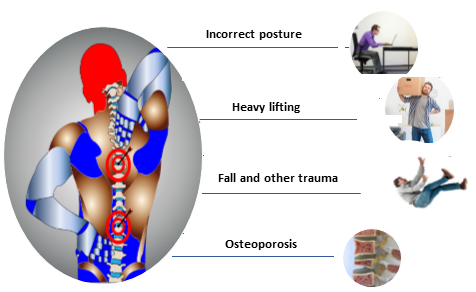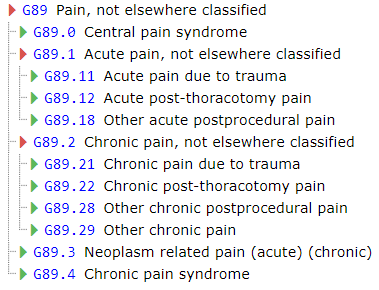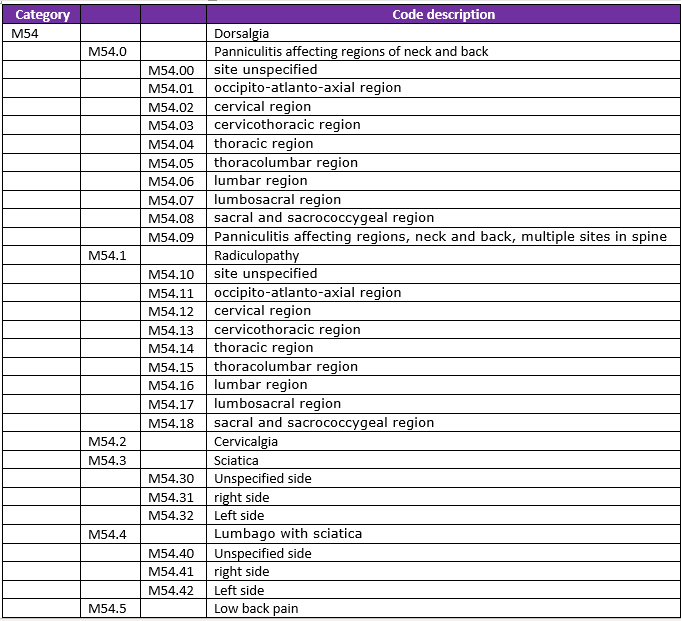Back Pain ICD 10
In this topic will come across Back pain ICD 10 coding guidelines and examples, but first let us learn about Back pain, common causes of the back pain and important terminologies related to back pain.
Back pain, medically called Dorsalgia is a very common physical discomfort affecting 8 out of 10 people both young and the old. The pain can be in the cervical, cervicothoracic, thoracic, thoracolumbar, Lumbar or lumbosacral regions. It can be felt as a dull, persistent ache or a sudden sharp pain.
Dorsalgia commonly results from injury, strenuous activity, improper sitting and sleeping postures, intervertebral disk disorders and other underlying medical conditions, or old age.
Some of the common causes of back pain

Definitions of important terminologies related to back pain
- Acute back pain– The pain which is starts suddenly and typically lasts for a few days to a few weeks is classified as acute pain.
- Chronic back pain– Back pain is said to be chronic if it is a constant nagging pain usually lasting for more than 3-6 months duration, which begins to affect the daily routine of the person.
- Cervical region– The neck region of the spine comprising of 7 vertebrae (C1 to C7)
- Cervicothoracic region– The region connecting the cervical and thoracic regions of the spine (C7-T1).
- Thoracic region– The longest region of the spine which extends from the base of the neck to the abdomen. It comprises of 12 vertebrae (T1 to T12).
- Thoracolumbar region– The connecting region between the 12th Thoracic and the 1st lumbar vertebrae (T12-L1). This is most injury prone region of the spine.
- Lumbar region– The lower back region of the spine which is curved slightly inwards and made of 5 vertebrae (L1-L5).
- Lumbosacral region– The region connecting the last lumbar vertebrae to the sacrum which is made of 5 bones fused together.
- Panniculitis- Inflammation of the fatty layer under the skin which leads to painful nodules on the skin.
- Radiculopathy- Pain, weakness, numbness and tingling caused due to compressed or pinched nerve along different areas of the spine. Nerve compression can occur due to a ruptured or herniated disk or due to other pathological conditions like tumors or abscess.
- Sciatica– Pain which radiates down to one or both the legs from the lower back caused due to compression of the sciatic nerve by a herniated disk or a bone spur.
- Lumbago- The medical term for low back pain.
Back pain ICD 10 Coding:
Like all other conditions, accurate ICD-10 coding of back pain too requires the specific documentation of the location and type. Back pain being a symptom of an underlying disease in most cases is coded only in the absence of a confirmed diagnosis of an underlying condition like intervertebral disc disorders, traumatic disc fracture, muscle strain etc.. These conditions need to be established with the aid of the diagnostic tests like an X-ray, MRI, CT scan or an Electro-myelogram.
When the patient’s back pain is specified as acute or chronic, due to trauma, post-procedural or neoplasm related, the code from the category G89 also needs to be coded along with the site-specific pain code. The sequencing of the codes will be based on the reason for the visit.

Back Pain ICD 10 Codes under the category M54 (Dorsalgia)


| Low Back Pain ICD 10 Example 1A 45-year- old male patient presents to the clinic for steroid injections for his pain. He has chronic lower back pain because of trauma suffered a few years ago. Code the appropriate ICD-10-CM code for the above scenario.
Ans: G89.21, M54.5 |
| Back Pain ICD 10 – Thoracic spine Example 2Emma is a 30-year-old female who visits her doctor due to acute pain in the thoracic spine. The doctor suspects thoracic spinal stenosis and has ordered an MRI of the thoracic spine. Code the appropriate diagnoses.
Ans: M54.6 (Thoracic spinal stenosis is not coded as this is a suspected condition) |
| Back Pain ICD 10 Example 3Tracy is a 75-year-old female suffering from senile osteoporosis. She complains of severe low back pain with no history of trauma. Her X-rays of the spine revealed pathological compression fractures of the L3 and L4 vertebrae. Code the appropriate ICD-10-CM code for the condition.
Ans: M80.08XA |
| Back Pain ICD 10 Example 4A 58-year-old male patient who is engaged in strenuous activities at work, visits the clinic with numbness and severe shooting pain originating from the left buttock to the posterior part of the left thigh and extending to the lateral part of the left foot. The physical examination, neurological and muscle strength test revealed his condition to be Lumbosacral radiculopathy. What will be the appropriate ICD-10-CM code?
Ans: M54.17 |